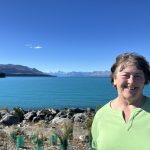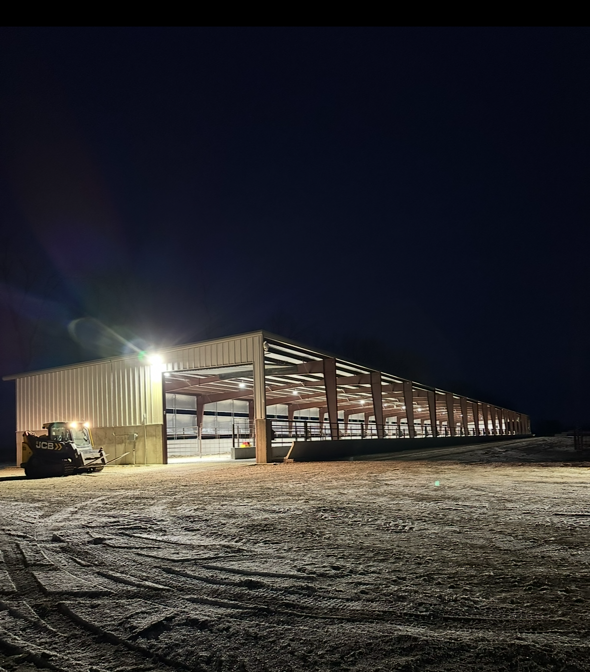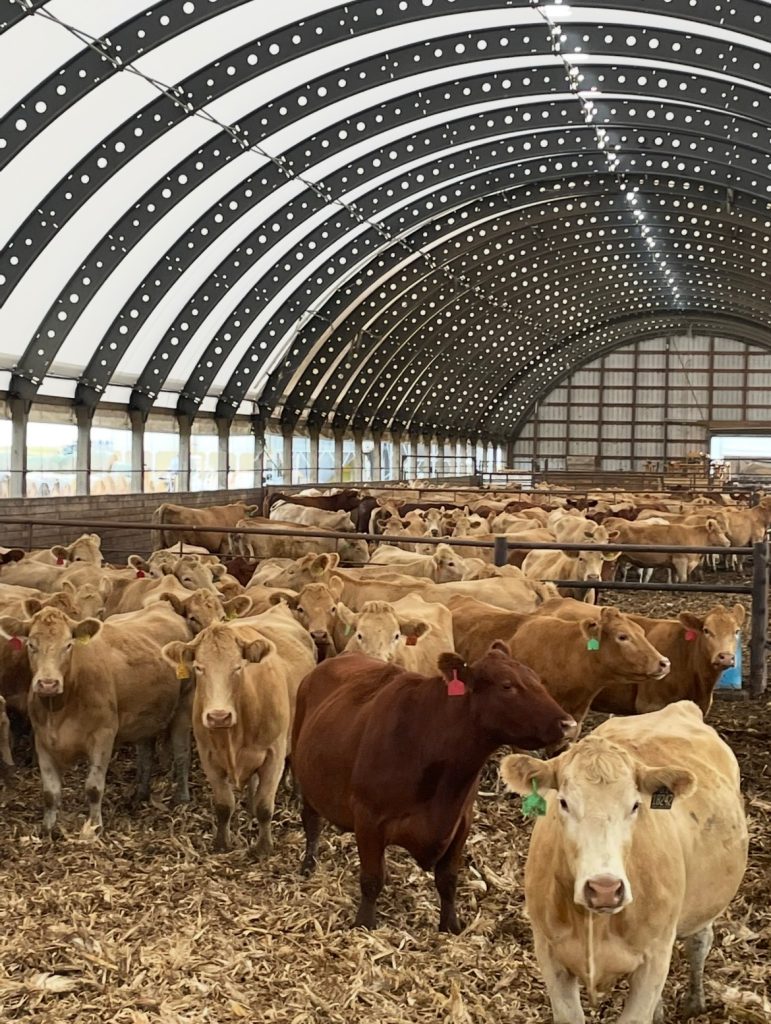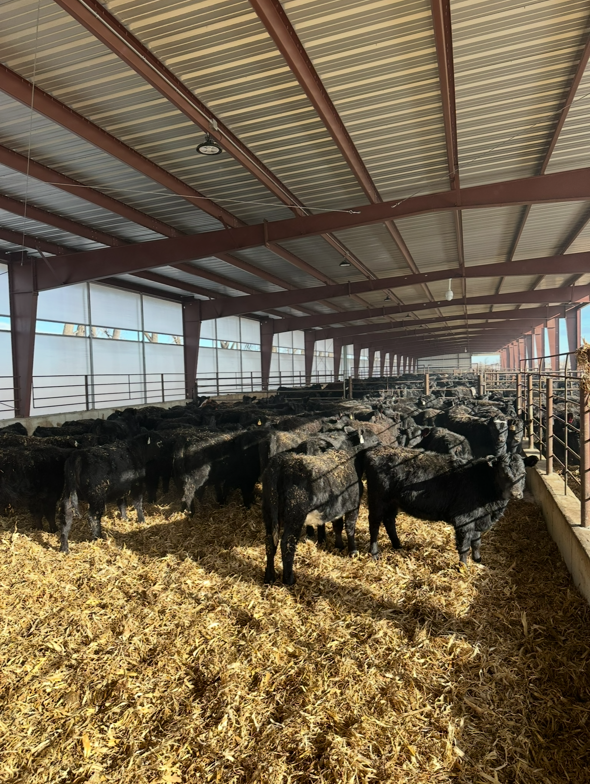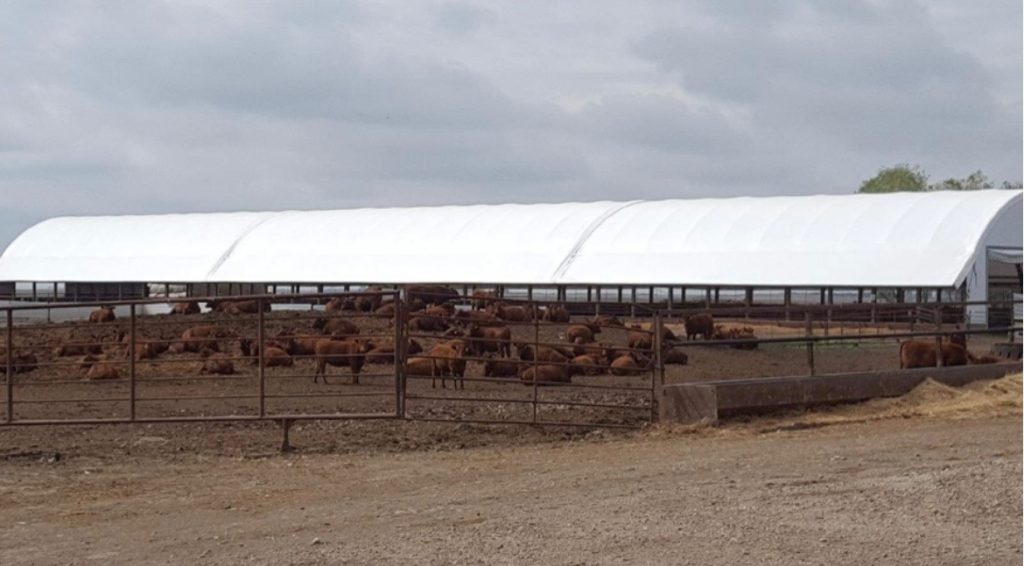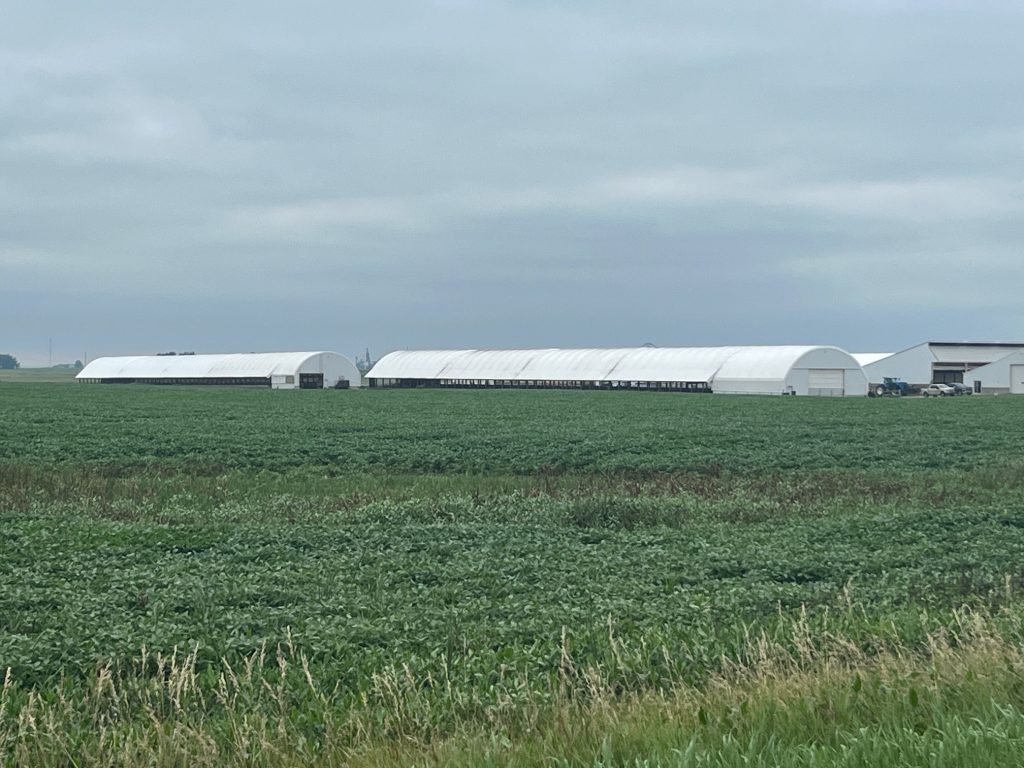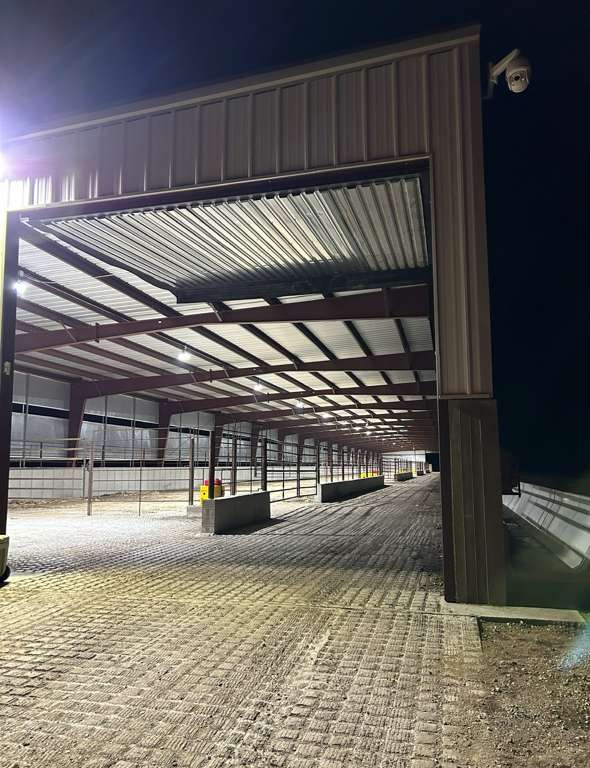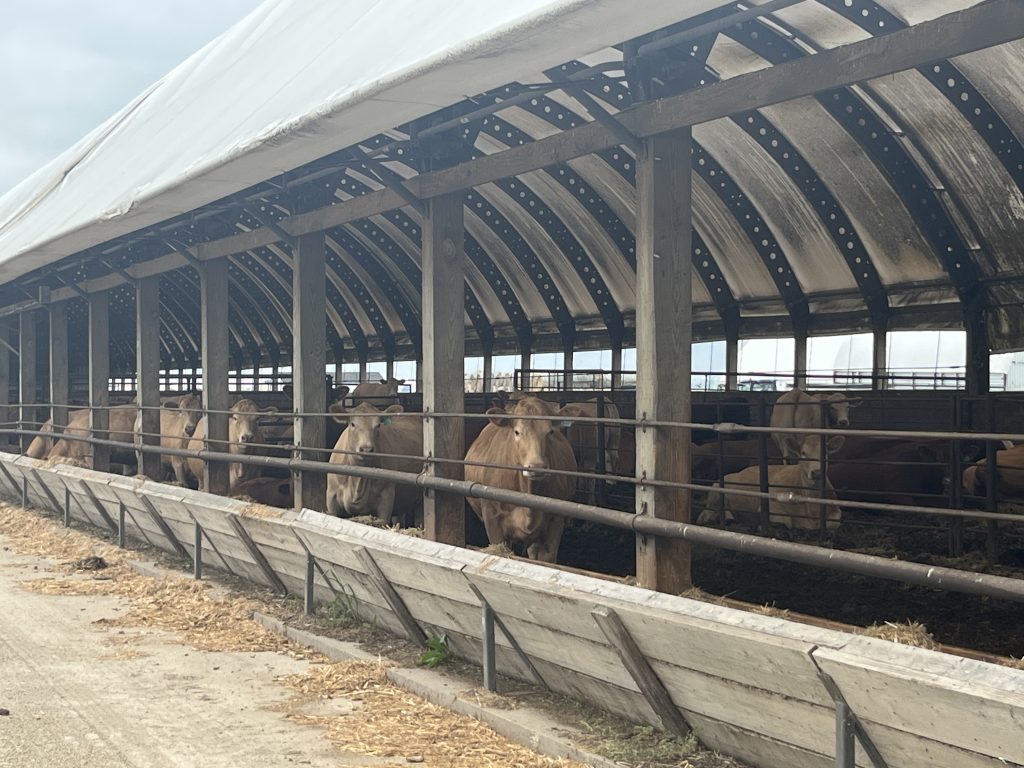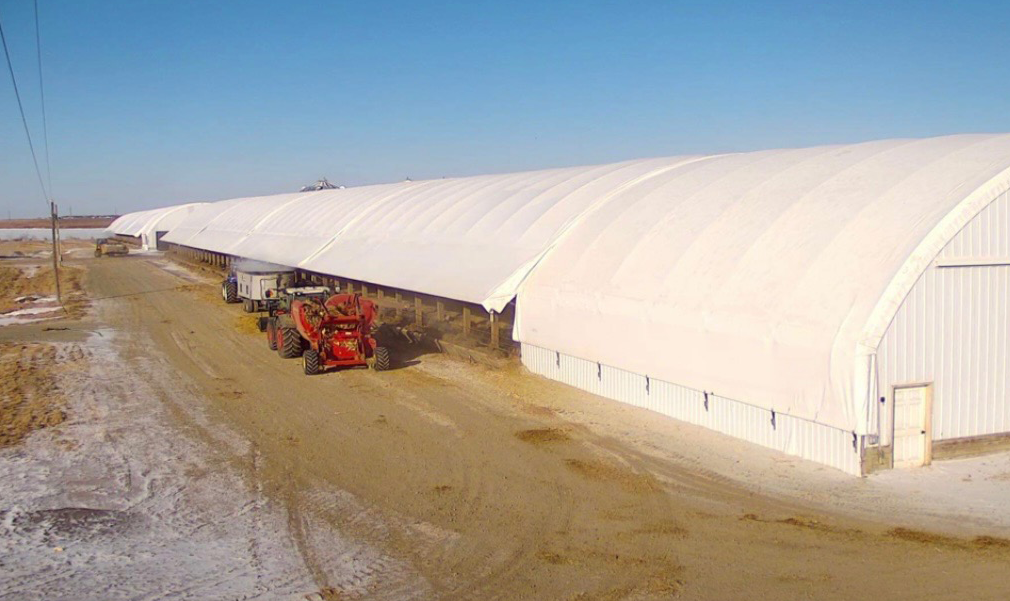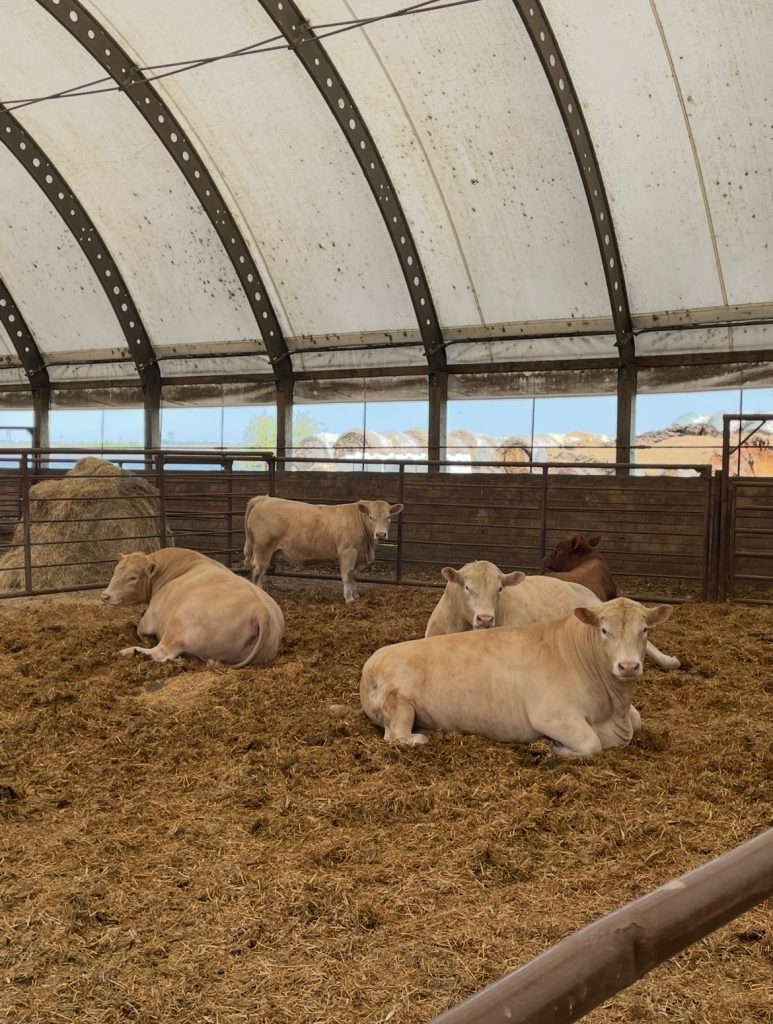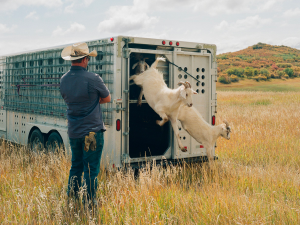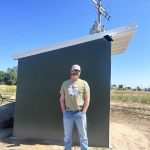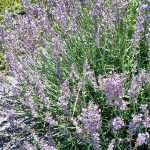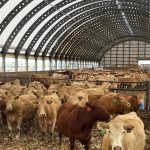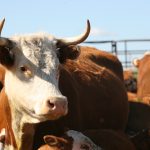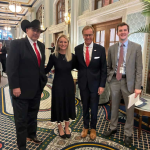2025 Fall Homeland | Choices: Is a hoop barn or a monoslope structure better for cattle?
Putting up a cattle barn is a big investment. A great deal of planning goes into the decision about what type of a barn to use for finishing or backgrounding cattle. Hoop barns and monoslope barns keep animals comfortable year-round, can boost performance in severe weather, lower sickness, and produce manure for fertilizer.
Cattle munch rations contentedly while standing in one of the three white canvas-covered shelters just southeast of Frederick, South Dakota. Built several years ago, the structures provide shelter for the animals owned by Ulmer Land and Cattle.
The 56′ x 500′ hoop barns were constructed in 2008, 2010, and 2013 and have served the cattle-feeding operation well. Owners Ross and Annette Ulmer added a monoslope barn in 2017 because, at that time, it was less expensive.
Ross Ulmer decided to build the 60′ x 175′ monoslope barn which has all wood trusses and is oriented north to south with an east opening. With added ventilation, the air quality is pretty comparable to the hoop building. He believes it’s better for the cows with calves to get the east sun. In the long run, the building may last longer.
“I really like the light provided in the hoop barns, you just can’t beat that,” Ross said. “I built a hoop commodity shed in 2022 because of the high roof. That really works well.”
Hoop structures are generally constructed with wood or concrete sidewalls, a tubular steel truss system, and a woven polyethylene fabric cover.
As far as cow comfort, Ulmer was determined to find the best type of building that he could use on his farm when he built the hoop structures. He wanted the set-up to be functional and efficient. He wanted to be able to operate it as one person. He spent a lot of time traveling to look at buildings and talking to others who had built similar structures.
Benefits
The hoop structures provide great natural lighting, comfortable conditions for the animals and use a compost bedpack for manure handling.
Ulmer feels the natural light is a great advantage of the structure. In the winter months as the days get shorter, the sunlight flows into the barns and warms the cattle. In the summer, the roof keeps the direct sun from the cattle yet illuminates the interior.
The barns allow a good airflow, which is beneficial for the cattle. The buildings are oriented in an east-west direction. In the summer, the curtains in back are rolled up for a horizontal airflow. In the wintertime, the curtains are closed, but ventilation continues to be important. The air flows from the back and takes the heat and moisture up and out the top of the building.
There is no curtain on the south side, just an eave to keep rain and snow out of the feed bunks. When the exterior temperature is consistently above 45 degrees, the back curtain is opened. During the summer, it will only be closed if there is a big rain or windstorm. It stays down during the winter.
In the summer, when it’s hot out, the interior is comfortable. Ulmer compares it to being underneath an umbrella. A wind of two to three mph can provide a great cooling effect. He’s observed that the animals don’t pant or stand by the water tank despite intense heat outside.
In the winter, when the barn is full of cattle, with the compost bedding pack, the area is generally at least 10 degrees warmer than outside.
A sorting and processing system in the farther west building allows the Ulmers to do all their artificial insemination work under a roof. They do that before the heifers are sent to pasture each summer.
In the winter, Ulmer said he sleeps soundly at night when a storm comes through.
“The cattle don’t know there is a blizzard,” he said. “I’ll need to scrape to get a path for the feed wagon, but there is no problem for the cows to get their food.”
No mucky mess
Ulmer intensely studied compost bedpacks and is pleased with the result in his barns. Inside, an area was packed with clay and limestone for a base for the compost. Ulmer said it doesn’t look any different than cement but provides an essential base that allows the manure to compost.
“When we start these barns in the fall, we put a lot of straw in there, about a foot deep,” Ulmer said. “The cattle will pack that down and there will be a layer of between 3 to 4 inches of yellow straw. There’s some science associated with the bedding pack and research about the best way to get the microbes to work in it. The compost has to work right or you’ll end up with ammoniated bedding.”
He has heard that if the pack is built on cement, the system won’t work, and it will result in a mucky manure mess.
Additional wheat straw is added as needed. The compost pack heats to about 140 degrees and will grow to be 2 to 3 feet deep. It is solid for the cows to walk across.
The manure is scraped at regular intervals, and Ulmer said that he’s been surprised that when cleaning the barn, the result is dry and crumbly. It has some moisture, almost like silage. The manure is totally cleaned out of the building twice a year.
The manure generated is valuable.
“We test it and spread it on our ground as fertilizer. We figure it has a value of about $40,000 when we put it on our fields,” he said.
Advantages
There is a lot of interest in the buildings. The cover should last for 15 years or more and withstand 120 mph winds. The heavy sealed canvas won’t really wear out, but the stitching exposed to the sun may start to come apart.
“If so, then the cover can be replaced in a couple of days,” Ulmer said. “It’s not a big deal. The next tarp may last for 40 years.”
Ulmer shared, “A few years ago, we had a big hailstorm come through that really ruined the steel roofs of the house and the monoslope. We had to replace those roofs but the hail just bounced off the hoop barns and they were fine.”
There is some maintenance involved a couple times a month to check to make sure all supporting straps are tight. If the covers get too loose, they can start flapping in the breeze and cause a lot of damage. He had one cover come loose during derecho winds a few years back. A couple of the trusses broke and they repaired that. The newer covers have a better glue over the stitching to prevent deterioration due to sun exposure.
“If a big storm came through and took down all the barns, I think I’d rebuild with monoslopes. I like the steel roof and the fact that it’s a building. I like the hoops but they are a little higher maintenance. I worry about the snow load on the hoop barns a little more. The hoops have much better lighting and you can’t get anywhere near that with a monoslope, even with extra lighting.
As he headed outside to finish chores, Ulmer said, “The barns have been one of our best returns on investment since we added our center pivot irrigation system years ago.”
Monoslope a choice near Oakes, North Dakota
For the Roney family cattle operation southeast of Oakes, North Dakota, Alex Roney, 22, said they started looking into funding for a new structure in December of 2022. He said, “When I was checking on buildings I told my dad, I want a steel building, not a tent.”
After weighing options and prices, the family decided a monoslope building would be best for their operation. Monoslope structures are constructed with concrete walls, steel frame, and steel roof. They sought funding through Natural Resources Conservation Service. Funding wasn’t available for 2023 and so the agency recommended another option. That was through the North Dakota Environmental Quality program and they were able to secure that grant. Housing manure within roofed structures effectively eliminates runoff and significantly reduces environmental risks when compared to open feedlot systems.
The operation includes Alex’s dad Pat who helps Alex with the cattle feeding, and his older brother Austin who handles the crop side of the business. “We each have our own niche but help out each other when needed. We can only do all we do because of the support my mom Kathy provides.”
In past years, the Roney family had an outdoor feedlot for about 150 head. The new barn will allow them to be able to background or finish 500 cattle.
“In July of 2024, we did all of the dirt work to get ready to build. We poured all the cement work for the 50′ x 425′ monoslope barn with a 50′ x 50′ manure bunker. We bought the pre-fab package and put it up ourselves. Dad has a metal fabrication business which made the decision easy for us. We love working with metal. We finished putting the building up in October of 2024. We finished up the fencing and gates later.'”
The family moved Black Angus calves they’d raised from the outdoor feedlot into the new barn December 8. Later, they bought more heifers and recently sold that group of calves.
The clay floor has a bedpack which builds up and is changed once or twice a year. The Drover’s alley is cleaned twice a week.
“Dad did a lot of looking into the benefits of using the manure and how we’d handle the manure when looking at the design of our barn,” Alex said. “I’m kept busy with cleaning the barn one or two times a week with our skid-steer and then replacing the bedding every 4 or 5 days. We use cornstalks for bedding.”
Once the crops are harvested from the fields, Alex will spread the manure as fertilizer in preparation for next year’s corn and soybean crops. With prices increasing for commercial fertilizer, using the cattle manure provides nutrients while saving substantial money.
Alex said, “Prices for cattle are really great. It’s a great year to have cattle to sell. We sold some at 975 lbs. a month ago. The sting comes when you need to buy cattle.”
